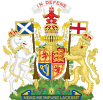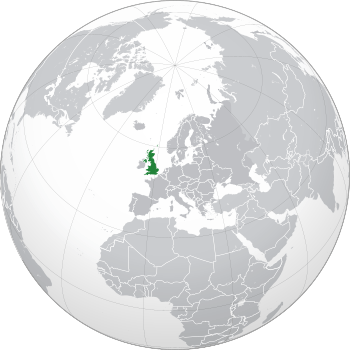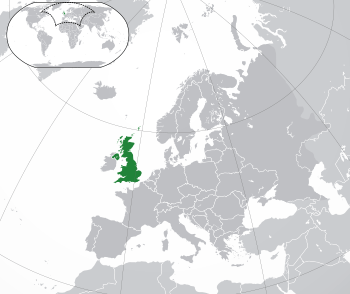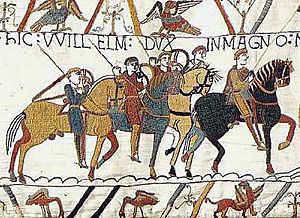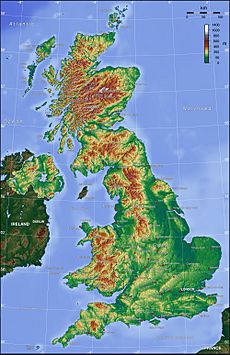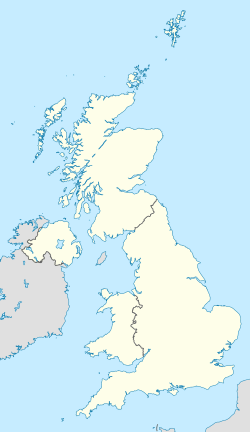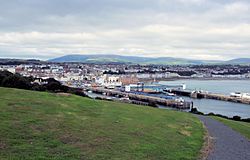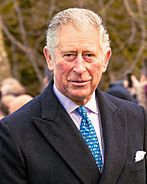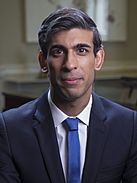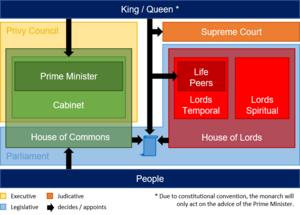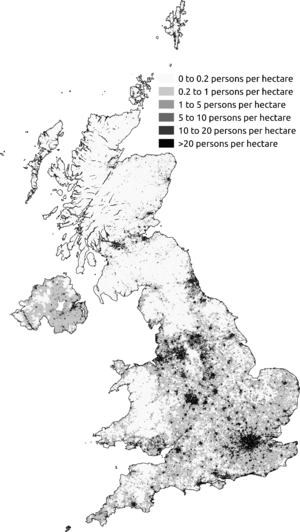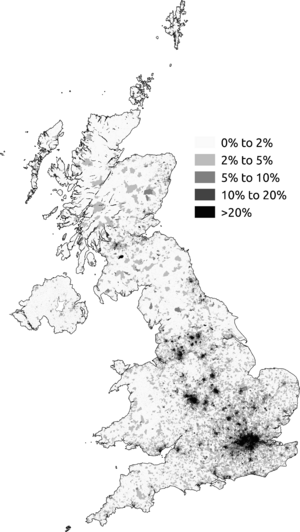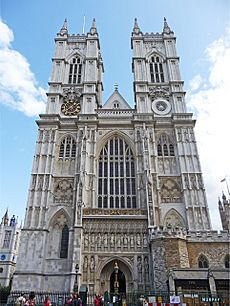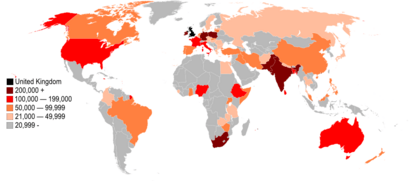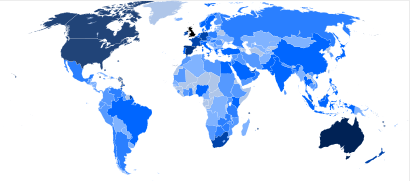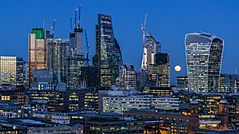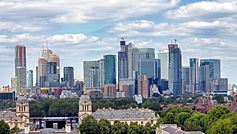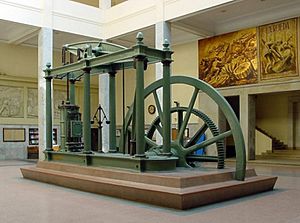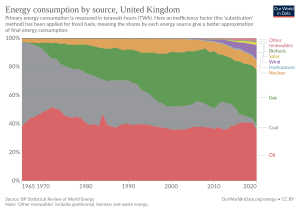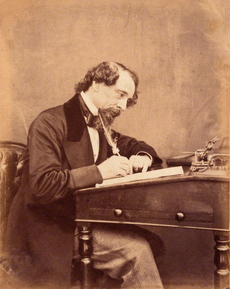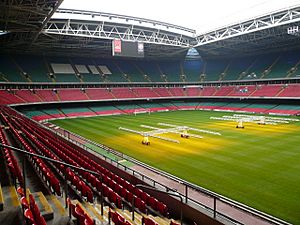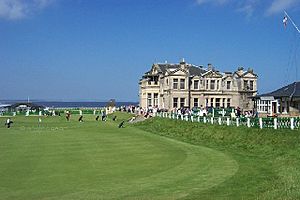United Kingdom facts for kids
Quick facts for kids
United Kingdom of Great Britain and Northern Ireland
|
|
|---|---|
|
Anthem: "God Save the King"
|
|
|
Location of the United Kingdom (dark green)
on the European continent (dark grey) |
|
| Capital and largest city
|
London 51°30′N 0°7′W / 51.500°N 0.117°W |
| Official language and national language |
English (de facto) |
| Regional and minority languages | |
| Ethnic groups
(2011)
|
|
| Religion
(2018)
|
|
| Demonym(s) |
|
| Constituent countries | |
| Government | Unitary parliamentary constitutional monarchy |
|
• Monarch
|
Charles III |
| Rishi Sunak | |
| Legislature | Parliament |
| House of Lords | |
| House of Commons | |
| Formation | |
| 1535 and 1542 | |
| 24 March 1603 | |
| 22 July 1706 | |
| 1 May 1707 | |
| 1 January 1801 | |
| 5 December 1922 | |
| Area | |
|
• Total
|
242,495 km2 (93,628 sq mi) (78th) |
|
• Water (%)
|
1.51 (2015) |
| Population | |
|
• 2022 estimate
|
67,791,400 (22nd) |
|
• 2011 census
|
63,182,178 (22nd) |
|
• Density
|
270.7/km2 (701.1/sq mi) (50th) |
| GDP (PPP) | 2022 estimate |
|
• Total
|
|
|
• Per capita
|
|
| GDP (nominal) | 2022 estimate |
|
• Total
|
|
|
• Per capita
|
|
| Gini (2019) | ▲ 36.6 medium · 33rd |
| HDI (2021) | very high · 18th |
| Currency | Pound sterling (GBP) |
| Time zone | UTC (Greenwich Mean Time, WET) |
|
• Summer (DST)
|
UTC+1 (British Summer Time, WEST) |
| Date format | dd/mm/yyyy yyyy-mm-dd (AD) |
| Driving side | left |
| Calling code | +44 |
| ISO 3166 code | GB |
| Internet TLD | .uk |
The United Kingdom of Great Britain and Northern Ireland, commonly known as the United Kingdom (UK) or Britain, is a country in Europe, off the north-western coast of the continental mainland. It comprises England, Scotland, Wales and Northern Ireland. The United Kingdom includes the island of Great Britain, the north-eastern part of the island of Ireland, and many smaller islands within the British Isles. Northern Ireland shares a land border with the Republic of Ireland; otherwise, the United Kingdom is surrounded by the Atlantic Ocean, the North Sea, the English Channel, the Celtic Sea and the Irish Sea. The total area of the United Kingdom is 242,495 square kilometres (93,628 sq mi), with an estimated 2020 population of more than 67 million people.
The United Kingdom is a constitutional monarchy and parliamentary democracy. The capital and largest city is London, a global city and financial centre with a metropolitan area population of over 14 million. Other major cities include Birmingham, Manchester, Glasgow, Liverpool and Leeds. Scotland, Wales, and Northern Ireland have their own devolved governments, each with varying powers.
The United Kingdom has evolved from a series of annexations, unions and separations of constituent countries over several hundred years. The Treaty of Union between the Kingdom of England (which included Wales, annexed in 1542) and the Kingdom of Scotland in 1707 formed the Kingdom of Great Britain. Its union in 1801 with the Kingdom of Ireland created the United Kingdom of Great Britain and Ireland. Most of Ireland seceded from the UK in 1922, leaving the present United Kingdom of Great Britain and Northern Ireland, which formally adopted that name in 1927. The UK became the world's first industrialised country and was the world's foremost power during the 19th and early 20th centuries. In the 21st century, the UK retains considerable economic, cultural, military, scientific, technological and political influence.
The nearby Isle of Man, Guernsey and Jersey are not part of the UK, being Crown Dependencies with the British Government responsible for defence and international representation. There are also 14 British Overseas Territories, the last remnants of the British Empire which, at its height in the 1920s, encompassed almost a quarter of the world's landmass and a third of the world's population, and was the largest empire in history. British influence can be observed in the language, culture and the legal and political systems of many of its former colonies.
The United Kingdom has the world's sixth-largest economy by nominal gross domestic product (GDP), and the eighth-largest by purchasing power parity. It has a high-income economy and a very high Human Development Index rating, ranking 18th in the world. It also performs well in international rankings of education, healthcare, life expectancy and human development. It is a recognised nuclear state and is ranked fourth globally in military expenditure. It has been a permanent member of the United Nations Security Council since its first session in 1946.
The United Kingdom is a member of the Commonwealth of Nations, the Council of Europe, the G7, the Group of Ten, the G20, Five Eyes, the United Nations, NATO, AUKUS, the Organisation for Economic Co-operation and Development (OECD), Interpol, and the World Trade Organization (WTO). It was a member state of the European Communities (EC) and its successor, the European Union (EU), from its accession in 1973 until its withdrawal in 2020 following a referendum held in 2016.
Contents
History
Before 1707
Settlement by anatomically modern humans of what was to become the United Kingdom occurred in waves beginning by about 30,000 years ago. By the end of the region's prehistoric period, the population is thought to have belonged, in the main, to a culture termed Insular Celtic, comprising Brythonic Britain and Gaelic Ireland. The Roman conquest, beginning in 43 AD, and the 400-year rule of southern Britain, was followed by an invasion by Germanic Anglo-Saxon settlers, reducing the Brythonic area mainly to what was to become Wales and the historic Kingdom of Strathclyde. Most of the region settled by the Anglo-Saxons became unified as the Kingdom of England in the 10th century. Meanwhile, Gaelic-speakers in north-west Britain (with connections to the north-east of Ireland and traditionally supposed to have migrated from there in the 5th century) united with the Picts to create the Kingdom of Scotland in the 9th century.
In 1066, the Normans invaded England from France and after its conquest, seized large parts of Wales, conquered much of Ireland and were invited to settle in Scotland, bringing to each country feudalism on the Northern French model and Norman-French culture. The Norman elites greatly influenced, but eventually assimilated with, each of the local cultures. Subsequent medieval English kings completed the conquest of Wales and made an unsuccessful attempt to annex Scotland. Following the Declaration of Arbroath, Scotland maintained its independence, albeit in near-constant conflict with England. The English monarchs, through inheritance of substantial territories in France and claims to the French crown, were also heavily involved in conflicts in France, most notably the Hundred Years War, while the Kings of Scots were in an alliance with the French during this period.
The early modern period saw religious conflict resulting from the Reformation and the introduction of Protestant state churches in each country. Wales was fully incorporated into the Kingdom of England, and Ireland was constituted as a kingdom in personal union with the English crown. In what was to become Northern Ireland, the lands of the independent Catholic Gaelic nobility were confiscated and given to Protestant settlers from England and Scotland.
In 1603, the kingdoms of England, Scotland and Ireland were united in a personal union when James VI, King of Scots, inherited the crowns of England and Ireland and moved his court from Edinburgh to London; each country nevertheless remained a separate political entity and retained its separate political, legal, and religious institutions.
In the mid-17th century, all three kingdoms were involved in a series of connected wars (including the English Civil War) which led to the temporary overthrow of the monarchy and the establishment of the short-lived unitary republic of the Commonwealth of England, Scotland and Ireland. During the 17th and 18th centuries, British sailors were involved in acts of piracy (privateering), attacking and stealing from ships off the coast of Europe and the Caribbean.
Although the monarchy was restored, the Interregnum ensured (along with the Glorious Revolution of 1688 and the subsequent Bill of Rights 1689, and the Claim of Right Act 1689) that, unlike much of the rest of Europe, royal absolutism would not prevail, and a professed Catholic could never accede to the throne. The British constitution would develop on the basis of constitutional monarchy and the parliamentary system. With the founding of the Royal Society in 1660, science was greatly encouraged. During this period, particularly in England, the development of naval power (and the interest in voyages of discovery) led to the acquisition and settlement of overseas colonies, particularly in North America.
After the Acts of Union of 1707
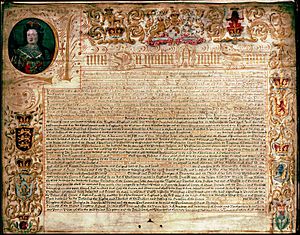
On 1 May 1707, the united Kingdom of Great Britain came into being, the result of Acts of Union being passed by the parliaments of England and Scotland to ratify the 1706 Treaty of Union and so unite the two kingdoms.
In the 18th century, cabinet government developed under Robert Walpole, in practice the first prime minister (1721–1742). A series of Jacobite Uprisings sought to remove the Protestant House of Hanover from the British throne and restore the Catholic House of Stuart. The Jacobites were finally defeated at the Battle of Culloden in 1746, after which the Scottish Highlanders were brutally suppressed. The British colonies in North America that broke away from Britain in the American War of Independence became the United States of America, recognised by Britain in 1783. British imperial ambition turned elsewhere, particularly to India.
During the 18th century, Britain was involved in the Atlantic slave trade. British ships transported an estimated two million slaves from Africa to the West Indies before banning the trade in 1807, banning slavery in 1833, and taking a leading role in the movement to abolish slavery worldwide by pressing other nations to end their trade with a series of treaties, and then formed the world's oldest international human rights organisation, Anti-Slavery International, in London in 1839. The term "United Kingdom" became official in 1801 when the parliaments of Britain and Ireland each passed an Act of Union, uniting the two kingdoms and creating the United Kingdom of Great Britain and Ireland.
In the early 19th century, the British-led Industrial Revolution began to transform the country. Gradually political power shifted away from the old Tory and Whig landowning classes towards the new industrialists. An alliance of merchants and industrialists with the Whigs would lead to a new party, the Liberals, with an ideology of free trade and laissez-faire. In 1832 Parliament passed the Great Reform Act, which began the transfer of political power from the aristocracy to the middle classes. In the countryside, enclosure of the land was driving small farmers out. Towns and cities began to swell with a new urban working class. Few ordinary workers had the vote, and they created their own organisations in the form of trade unions.
After the defeat of France at the end of the Revolutionary and Napoleonic Wars (1792–1815), the United Kingdom emerged as the principal naval and imperial power of the 19th century (with London the largest city in the world from about 1830). Unchallenged at sea, British dominance was later described as Pax Britannica ("British Peace"), a period of relative peace in Europe and the world (1815–1914) during which the British Empire became the global hegemon and adopted the role of global policeman. By the time of the Great Exhibition of 1851, Britain was described as the "workshop of the world". The British Empire was expanded to include India, large parts of Africa and many other territories throughout the world. Alongside the formal control it exerted over its own colonies, British dominance of much of world trade meant that it effectively controlled the economies of many regions, such as Asia and Latin America. Domestically, political attitudes favoured free trade and laissez-faire policies and a gradual widening of the voting franchise. During the century, the population increased at a dramatic rate, accompanied by rapid urbanisation, causing significant social and economic stresses. To seek new markets and sources of raw materials, the Conservative Party under Disraeli launched a period of imperialist expansion in Egypt, South Africa, and elsewhere. Canada, Australia, and New Zealand became self-governing dominions. After the turn of the century, the United Kingdom's industrial monopoly was challenged by Germany and the United States.
Social reform and home rule for Ireland were important domestic issues after 1900. The Labour Party emerged from an alliance of trade unions and small Socialist groups in 1900, and suffragettes campaigned for women's right to vote before 1914.

The United Kingdom fought with France, Russia and (after 1917) the United States, against Germany and its allies in the First World War (1914–1918). The United Kingdom armed forces were engaged across much of the British Empire and in several regions of Europe, particularly on the Western front. The high fatalities of trench warfare caused the loss of much of a generation of men, with lasting social effects in the nation and a great disruption in the social order.
After the war, the United Kingdom received the League of Nations mandate over a number of former German and Ottoman colonies. The British Empire reached its greatest extent, covering a fifth of the world's land surface and a quarter of its population. However, the United Kingdom had suffered 2.5 million casualties and finished the war with a huge national debt.
The rise of Irish nationalism, and disputes within Ireland over the terms of Irish Home Rule, led eventually to the partition of the island in 1921. The Irish Free State became independent with Dominion status in 1922. Northern Ireland remained part of the United Kingdom. A wave of strikes in the mid-1920s culminated in the United Kingdom General Strike of 1926. The United Kingdom had still not recovered from the effects of the war when the Great Depression (1929–1932) occurred. This led to considerable unemployment and hardship in the old industrial areas, as well as political and social unrest in the 1930s, with rising membership in communist and socialist parties. A coalition government was formed in 1931.
The United Kingdom entered the Second World War by declaring war on Germany in 1939, after the Nazi regime had invaded Poland and Czechoslovakia. Winston Churchill became prime minister and head of a coalition government in 1940. Despite the defeat of its European allies in the first year of the war, the United Kingdom continued the fight alone against Germany. In 1940, the RAF defeated the German Luftwaffe in a struggle for control of the skies in the Battle of Britain. The United Kingdom suffered heavy bombing during the Blitz. There were also eventual hard-fought victories in the Battle of the Atlantic, the North Africa campaign and Burma campaign. United Kingdom forces played an important role in the Normandy landings of 1944, achieved with its United States ally.
Since 1945

After the end of the Second World War in 1945, the UK was one of the Big Four powers (the Soviet Union, the United Kingdom, the US and China) who met to plan the post-war world; it was an original signatory to the Declaration of the United Nations. The UK became one of the five permanent members of the United Nations Security Council. However, the war left the UK severely weakened and depending financially on the Marshall Plan. In the immediate post-war years, the Labour government initiated a radical programme of reforms, which had a significant effect on British society in the following decades. Major industries and public utilities were nationalised, a welfare state was established, and a comprehensive, publicly funded healthcare system, the National Health Service, was created. The rise of nationalism in the colonies coincided with Britain's now much-diminished economic position, so that a policy of decolonisation was unavoidable. Independence was granted to India and Pakistan in 1947. Over the next three decades, most colonies of the British Empire gained their independence. Many became members of the Commonwealth of Nations.
Although the UK was the third country to develop a nuclear weapons arsenal (with its first atomic bomb test in 1952), the new post-war limits of Britain's international role were illustrated by the Suez Crisis of 1956. The international spread of the English language ensured the continuing international influence of its literature and culture. As a result of a shortage of workers in the 1950s, the government encouraged immigration from Commonwealth countries. In the following decades, the UK became a more multi-ethnic society than before. Despite rising living standards in the late 1950s and 1960s, the UK's economic performance was not as successful as many of its competitors, such as West Germany and Japan.
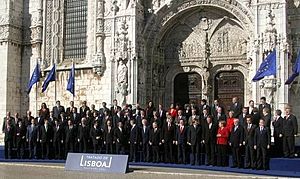
In the decade-long process of European integration, the UK was a founding member of the alliance called the Western European Union, established with the London and Paris Conferences in 1954. In 1960 the UK was one of the seven founding members of the European Free Trade Association (EFTA), but in 1973 it left to join the European Communities (EC). When the EC became the European Union (EU) in 1992, the UK was one of the 12 founding members. The Treaty of Lisbon was signed in 2007, which forms the constitutional basis of the European Union since then.
From the late 1960s, Northern Ireland suffered communal and paramilitary violence (sometimes affecting other parts of the UK) conventionally known as the Troubles. It is usually considered to have ended with the Belfast "Good Friday" Agreement of 1998.
Following a period of widespread economic slowdown and industrial strife in the 1970s, the Conservative government of the 1980s under Margaret Thatcher initiated a radical policy of monetarism, deregulation, particularly of the financial sector (for example, Big Bang in 1986) and labour markets, the sale of state-owned companies (privatisation), and the withdrawal of subsidies to others. This resulted in high unemployment and social unrest, but ultimately also economic growth, particularly in the services sector. From 1984, the economy was helped by the inflow of substantial North Sea oil revenues.
Around the end of the 20th century there were major changes to the governance of the UK with the establishment of devolved administrations for Scotland, Wales and Northern Ireland. The statutory incorporation followed acceptance of the European Convention on Human Rights. The UK is still a key global player diplomatically and militarily. It plays leading roles in the EU, UN and NATO. However, controversy surrounds some of Britain's overseas military deployments, particularly in Afghanistan and Iraq.
21st century
The UK broadly supported the United States' approach to the War on Terror in the early years of the 21st century. Controversy surrounded some of Britain's overseas military deployments, particularly in Afghanistan and Iraq.
The 2008 global financial crisis severely affected the UK economy. The Cameron–Clegg coalition government of 2010 introduced austerity measures intended to tackle the substantial public deficits which resulted. The devolved Scottish Government and UK government agreed for a referendum to be held on Scottish independence in 2014. This referendum resulted in the electorate in Scotland voting by 55.3 to 44.7% for Scotland to remain part of the United Kingdom.
In 2016, 51.9 per cent of voters in the United Kingdom voted to leave the European Union. The UK left the EU on 31 January 2020 and completed its withdrawal in full at the end of that year. The COVID-19 pandemic had a major impact on the UK in 2020 and 2021.
On 8 September 2022, Elizabeth II, the longest-living and longest-reigning British monarch, died at the age of 96 at Balmoral Castle in Scotland. The official announcement came at 18:30 BST. Earlier in the day, doctors reported that her health had been deteriorating rapidly and placed her under medical supervision.
Geography
The total area of the United Kingdom is approximately 243,610 square kilometres (94,060 sq mi). The country occupies the major part of the British Isles archipelago and includes the island of Great Britain, the north-eastern one-sixth of the island of Ireland and some smaller surrounding islands. It lies between the North Atlantic Ocean and the North Sea with the south-east coast coming within 22 miles (35 km) of the coast of northern France, from which it is separated by the English Channel. In 1993 10% of the UK was forested, 46% used for pastures and 25% cultivated for agriculture. The Royal Greenwich Observatory in London is the defining point of the Prime Meridian.
The United Kingdom lies between latitudes 49° to 61° N, and longitudes 9° W to 2° E. Northern Ireland shares a 224-mile (360 km) land boundary with the Republic of Ireland. The coastline of Great Britain is 11,073 miles (17,820 km) long. It is connected to continental Europe by the Channel Tunnel, which at 31 miles (50 km) (24 miles (38 km) underwater) is the longest underwater tunnel in the world.
England accounts for just over half of the total area of the UK, covering 130,395 square kilometres (50,350 sq mi). Most of the country consists of lowland terrain, with mountainous terrain north-west of the Tees-Exe line; including the Cumbrian Mountains of the Lake District, the Pennines, Exmoor and Dartmoor. The main rivers and estuaries are the Thames, Severn and the Humber. England's highest mountain is Scafell Pike (978 metres (3,209 ft)) in the Lake District. Its principal rivers are the Severn, Thames, Humber, Tees, Tyne, Tweed, Avon, Exe and Mersey.
Scotland accounts for just under a third of the total area of the UK, covering 78,772 square kilometres (30,410 sq mi) and including nearly eight hundred islands, predominantly west and north of the mainland; notably the Hebrides, Orkney Islands and Shetland Islands. Scotland is the most mountainous country in the UK and its topography is distinguished by the Highland Boundary Fault—a geological rock fracture—which traverses Scotland from Arran in the west to Stonehaven in the east. The fault separates two distinctively different regions; namely the Highlands to the north and west and the lowlands to the south and east. The more rugged Highland region contains the majority of Scotland's mountainous land, including Ben Nevis which at 1,343 metres (4,406 ft) is the highest point in the British Isles. Lowland areas—especially the narrow waist of land between the Firth of Clyde and the Firth of Forth known as the Central Belt—are flatter and home to most of the population including Glasgow, Scotland's largest city, and Edinburgh, its capital and political centre, although upland and mountainous terrain lies within the Southern Uplands.
Wales accounts for less than a tenth of the total area of the UK, covering 20,779 square kilometres (8,020 sq mi). Wales is mostly mountainous, though South Wales is less mountainous than North and mid Wales. The main population and industrial areas are in South Wales, consisting of the coastal cities of Cardiff, Swansea and Newport, and the South Wales Valleys to their north. The highest mountains in Wales are in Snowdonia and include Snowdon (Welsh: Yr Wyddfa) which, at 1,085 metres (3,560 ft), is the highest peak in Wales. The 14, or possibly 15, Welsh mountains over 3,000 feet (910 metres) high are known collectively as the Welsh 3000s. Wales has over 2,704 kilometres (1,680 miles) of coastline. Several islands lie off the Welsh mainland, the largest of which is Anglesey (Ynys Môn) in the north-west.
Northern Ireland, separated from Great Britain by the Irish Sea and North Channel, has an area of 14,160 square kilometres (5,470 sq mi) and is mostly hilly. It includes Lough Neagh which, at 388 square kilometres (150 sq mi), is the largest lake in the British Isles by area. The highest peak in Northern Ireland is Slieve Donard in the Mourne Mountains at 852 metres (2,795 ft).
Climate
The United Kingdom has a temperate climate, with plentiful rainfall all year round. The temperature varies with the seasons seldom dropping below −11 °C (12 °F) or rising above 35 °C (95 °F). The prevailing wind is from the south-west and bears frequent spells of mild and wet weather from the Atlantic Ocean, although the eastern parts are mostly sheltered from this wind since the majority of the rain falls over the western regions the eastern parts are therefore the driest. Atlantic currents, warmed by the Gulf Stream, bring mild winters; especially in the west where winters are wet and even more so over high ground. Summers are warmest in the south-east of England, being closest to the European mainland, and coolest in the north. Heavy snowfall can occur in winter and early spring on high ground, and occasionally settles to great depth away from the hills.
Administrative divisions
There is no consistent system of administrative or geographic demarcation across the United Kingdom. Each country of the United Kingdom has its own arrangements, whose origins often pre-date the UK's formation. Until the 19th century there was little change to those arrangements, but there has since been a constant evolution of role and function, most significantly the devolution of powers to Scotland, Wales and Northern Ireland.
The organisation of local government in England is complex, with the distribution of functions varying according to local arrangements. Legislation concerning local government in England is the responsibility of the UK's parliament and the government, as England has no devolved legislature. The upper-tier subdivisions of England are the nine regions, now used primarily for statistical purposes. One region, Greater London, has had a directly elected assembly and mayor since 2000 following popular support for the proposal in a referendum. It was intended that other regions would also be given their own elected regional assemblies, but a proposed assembly in the North East region was rejected by a referendum in 2004. Below the regional tier, some parts of England have county councils and district councils and others have unitary authorities; while London consists of 32 London boroughs and the City of London. Councillors are elected by the first-past-the-post system in single-member wards or by the multi-member plurality system in multi-member wards.
For local government purposes, Scotland is divided into 32 council areas, with wide variation in both size and population. The cities of Glasgow, Edinburgh, Aberdeen and Dundee are separate council areas, as is the Highland Council which includes a third of Scotland's area but only just over 200,000 people. Local councils are made up of elected councillors, of whom there are 1,223; they are paid a part-time salary. Elections are conducted by single transferable vote in multi-member wards that elect either three or four councillors. Each council elects a Provost, or Convenor, to chair meetings of the council and to act as a figurehead for the area. Councillors are subject to a code of conduct enforced by the Standards Commission for Scotland. The representative association of Scotland's local authorities is the Convention of Scottish Local Authorities (COSLA).
Local government in Wales consists of 22 unitary authorities. These include the cities of Cardiff, Swansea and Newport which are unitary authorities in their own right. Elections are held every four years under the first-past-the-post system. The most recent elections were held in May 2012, except for the Isle of Anglesey. The Welsh Local Government Association represents the interests of local authorities in Wales.
Local government in Northern Ireland has since 1973 been organised into 26 district councils, each elected by single transferable vote. Their powers are limited to services such as collecting waste, controlling dogs and maintaining parks and cemeteries. On 13 March 2008 the executive agreed on proposals to create 11 new councils and replace the present system. The next local elections were postponed until 2016 to facilitate this.
Dependencies
The United Kingdom has sovereignty over seventeen territories which do not form part of the United Kingdom itself: fourteen British Overseas Territories and three Crown dependencies.
The fourteen British Overseas Territories are: Anguilla; Bermuda; the British Antarctic Territory; the British Indian Ocean Territory; the British Virgin Islands; the Cayman Islands; the Falkland Islands; Gibraltar; Montserrat; Saint Helena, Ascension and Tristan da Cunha; the Turks and Caicos Islands; the Pitcairn Islands; South Georgia and the South Sandwich Islands; and Sovereign Base Areas on Cyprus. British claims in Antarctica are not universally recognised. Collectively Britain's overseas territories encompass an approximate land area of 1,727,570 square kilometres (667,018 sq mi) and a population of approximately 260,000 people. They are the remnants of the British Empire and several have specifically voted to remain British territories (Bermuda in 1995, Gibraltar in 2002 and the Falkland Islands in 2013).
The Crown dependencies are possessions of the Crown, as opposed to overseas territories of the UK. They comprise three independently administered jurisdictions: the Channel Islands of Jersey and Guernsey in the English Channel, and the Isle of Man in the Irish Sea. By mutual agreement, the British Government manages the islands' foreign affairs and defence and the UK Parliament has the authority to legislate on their behalf. However, internationally, they are regarded as "territories for which the United Kingdom is responsible". The power to pass legislation affecting the islands ultimately rests with their own respective legislative assemblies, with the assent of the Crown (Privy Council or, in the case of the Isle of Man, in certain circumstances the Lieutenant-Governor). Since 2005 each Crown dependency has had a Chief Minister as its head of government.
The British dependencies use a varied assortment of currencies. These include the British pound, US dollar, New Zealand dollar, euro or their own currencies, which may be pegged to either.
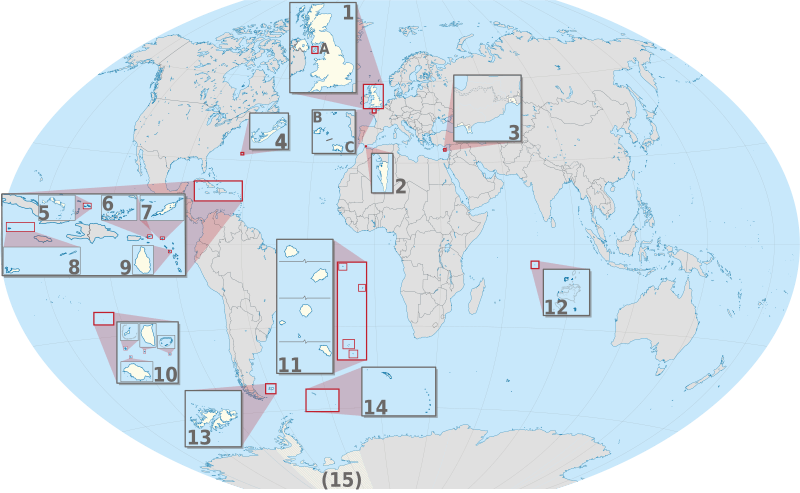
A Isle of Man; B Guernsey; C Jersey; 1 United Kingdom; 2 Gibraltar; 3 Akrotiri and Dhekelia; 4 Bermuda; 5 Turks and Caicos Islands; 6 British Virgin Islands; 7 Anguilla; 8 Cayman Islands; 9 Montserrat; 10 Pitcairn Islands; 11 Saint Helena, Ascension and Tristan da Cunha; 12 British Indian Ocean Territory; 13 Falkland Islands; 14 South Georgia and the South Sandwich Islands; (15) British Antarctic Territory
Parliament
The British people are represented by members of Parliament, not ruled by monarchs. However, after the English Civil War, Oliver Cromwell became Lord Protector, and the monarchy was disbanded. Though the monarchy was restored after his death, the Crown slowly became the secondary power, and Parliament the first. Members of Parliament (called MPs) were elected, but until the early twentieth century, only men who owned property could vote. In the nineteenth century, more people were given suffrage (the right to vote), but even so, by 1900, women could not vote, and only 40% of men were rich enough to vote. But in 1928, all adults, male and female, got the vote: this is called universal suffrage.
Parliament is in London, but it has power over the whole of the UK. Today, Wales, Scotland and Northern Ireland each have their own seats of local government but they have more limited powers; Scotland has the self named Scottish Parliament. The Welsh have an assembly and the Northern Irish have Stormount. There isn't an individual English parliament representing the views of only English regions. There are also parliaments in the Isle of Man and the Channel Islands, which are islands that are partly controlled by the UK, and partly independent.
The members of Parliament belong to political parties: the biggest parties are the Conservative Party, Labour Party, the Scottish National Party and the Liberal Democrats. Members of the same party agree to act and vote more or less together. A party with more than half the seats (a majority) forms the government; the leader of the party becomes the Prime Minister, who then appoints other ministers. Because the government has a majority in Parliament, it can normally control what laws are passed.
Government and politics
The United Kingdom is a unitary state under a constitutional monarchy. King Charles III is the monarch and head of state of the UK, as well as 14 other independent countries. These 15 countries are sometimes referred to as "Commonwealth realms". The monarch has "the right to be consulted, the right to encourage, and the right to warn". The Constitution of the United Kingdom is uncodified and consists mostly of a collection of disparate written sources, including statutes, judge-made case law and international treaties, together with constitutional conventions. The UK Parliament can carry out constitutional reform by passing acts of parliament, and thus has the political power to change or abolish almost any written or unwritten element of the constitution. No sitting parliament can pass laws that future parliaments cannot change.

The UK is a parliamentary democracy and a constitutional monarchy. The Parliament of the United Kingdom is sovereign. It is made up of the House of Commons, the House of Lords and the Crown. The main business of parliament takes place in the two houses, but royal assent is required for a bill to become an act of parliament (law).
For general elections (elections to the House of Commons), the UK is divided into 650 constituencies, each of which is represented by a member of Parliament (MP). MPs hold office for up to five years and are always up for re-election in general elections. The Conservative Party, Labour Party and Scottish National Party are, respectively, the current first, second and third largest parties (by number of MPs) in the House of Commons.
The prime minister is the head of government in the United Kingdom. Nearly all prime ministers have served as First Lord of the Treasury and all prime ministers have continuously served as First Lord of the Treasury since 1905, Minister for the Civil Service since 1968 and Minister for the Union since 2019. In modern times, the prime minister is, by constitutional convention, an MP. The prime minister is appointed by the monarch and their appointment is governed by constitutional conventions. However, they are normally the leader of the political party with the most seats in the House of Commons and hold office by virtue of their ability to command the confidence of the House of Commons.
The prime minister not only has statutory functions (alongside other ministers), but is the monarch's principal adviser and it is for them to advise the monarch on the exercise of the royal prerogative in relation to government. In particular, the prime minister recommends the appointment of ministers and chairs the Cabinet.
Demographics
A census is taken simultaneously in all parts of the UK every 10 years. In the 2011 census the total population of the United Kingdom was 63,181,775. It is the fourth-largest in Europe (after Russia, Germany and France), the fifth-largest in the Commonwealth and the 22nd-largest in the world. In mid-2014 and mid-2015 net long-term international migration contributed more to population growth. In mid-2012 and mid-2013 natural change contributed the most to population growth. Between 2001 and 2011 the population increased by an average annual rate of approximately 0.7 per cent. This compares to 0.3 per cent per year in the period 1991 to 2001 and 0.2 per cent in the decade 1981 to 1991. The 2011 census also showed that, over the previous 100 years, the proportion of the population aged 0–14 fell from 31 per cent to 18 per cent, and the proportion of people aged 65 and over rose from 5 to 16 per cent. In 2018 the median age of the UK population was 41.7 years.
England's population in 2011 was 53 million, representing some 84 per cent of the UK total. It is one of the most densely populated countries in the world, with 420 people resident per square kilometre in mid-2015, with a particular concentration in London and the south-east. The 2011 census put Scotland's population at 5.3 million, Wales at 3.06 million and Northern Ireland at 1.81 million.
In 2017 the average total fertility rate (TFR) across the UK was 1.74 children born per woman. While a rising birth rate is contributing to population growth, it remains considerably below the baby boom peak of 2.95 children per woman in 1964, or the high of 6.02 children born per woman in 1815, below the replacement rate of 2.1, but higher than the 2001 record low of 1.63. In 2011, 47.3 per cent of births in the UK were to unmarried women. The Office for National Statistics published a bulletin in 2015 showing that, out of the UK population aged 16 and over, 1.7 per cent identify as gay, lesbian, or bisexual (2.0 per cent of males and 1.5 per cent of females); 4.5 per cent of respondents responded with "other", "I don't know", or did not respond. The number of transgender people in the UK was estimated to be between 65,000 and 300,000 by research between 2001 and 2008.
| Largest urban areas of the United Kingdom (England and Wales: 2011 census built-up area; Scotland: 2012 estimates urban area; Northern Ireland: 2001 census urban area) |
|||||||||
|---|---|---|---|---|---|---|---|---|---|
| Rank | Urban area | Pop. | Principal settlement | Rank | Urban area | Pop. | Principal settlement | ||
 Greater London Urban Area |
1 | Greater London Urban Area | 9,787,426 | London | 11 | Bristol Urban Area | 617,280 | Bristol | 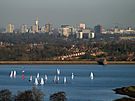 West Midlands Urban Area |
| 2 | Greater Manchester Urban Area | 2,553,379 | Manchester | 12 | Leicester Urban Area | 508,916 | Leicester | ||
| 3 | West Midlands Urban Area | 2,440,986 | Birmingham | 13 | Edinburgh Urban Area | 488,610 | Edinburgh | ||
| 4 | West Yorkshire Urban Area | 1,777,934 | Leeds | 14 | Belfast Urban Area | 483,418 | Belfast | ||
| 5 | Greater Glasgow | 1,199,629 | Glasgow | 15 | Brighton/Worthing/Littlehampton | 474,485 | Brighton | ||
| 6 | Liverpool Urban Area | 864,122 | Liverpool | 16 | South East Dorset conurbation | 466,266 | Bournemouth | ||
| 7 | South Hampshire | 855,569 | Southampton | 17 | Cardiff Urban Area | 390,214 | Cardiff | ||
| 8 | Tyneside | 774,891 | Newcastle | 18 | Teesside | 376,633 | Middlesbrough | ||
| 9 | Nottingham Urban Area | 729,977 | Nottingham | 19 | The Potteries Urban Area | 372,775 | Stoke-on-Trent | ||
| 10 | Sheffield Urban Area | 685,368 | Sheffield | 20 | Coventry and Bedworth Urban Area | 359,262 | Coventry | ||
Ethnic groups
Historically, indigenous British people were thought to be descended from the various ethnic groups that settled there before the 12th century: the Celts, Romans, Anglo-Saxons, Norse and the Normans. Welsh people could be the oldest ethnic group in the UK. A 2006 genetic study shows that more than 50 per cent of England's gene pool contains Germanic Y chromosomes. Another 2005 genetic analysis indicates that "about 75 per cent of the traceable ancestors of the modern British population had arrived in the British isles by about 6,200 years ago, at the start of the British Neolithic or Stone Age", and that the British broadly share a common ancestry with the Basque people.
The UK has a history of non-white immigration with Liverpool having the oldest Black population in the country dating back to at least the 1730s during the period of the African slave trade. During this period it is estimated the Afro-Caribbean population of Great Britain was 10,000 to 15,000 which later declined due to the abolition of slavery. The UK also has the oldest Chinese community in Europe, dating to the arrival of Chinese seamen in the 19th century. In 1950 there were probably fewer than 20,000 non-white residents in Britain, almost all born overseas. In 1951 there were an estimated 94,500 people living in Britain who had been born in South Asia, China, Africa and the Caribbean, just under 0.2 per cent of the UK population. By 1961 this number had more than quadrupled to 384,000, just over 0.7 per cent of the United Kingdom population.
Since 1948 substantial immigration from Africa, the Caribbean and South Asia has been a legacy of ties forged by the British Empire. Migration from new EU member states in Central and Eastern Europe since 2004 has resulted in growth in these population groups, although some of this migration has been temporary. Since the 1990s, there has been substantial diversification of the immigrant population, with migrants to the UK coming from a much wider range of countries than previous waves, which tended to involve larger numbers of migrants coming from a relatively small number of countries. Academics have argued that the ethnicity categories employed in British national statistics, which were first introduced in the 1991 census, involve confusion between the concepts of ethnicity and race. In 2011[update], 87.2 per cent of the UK population identified themselves as white, meaning 12.8 per cent of the UK population identify themselves as of one of number of ethnic minority groups. In the 2001 census, this figure was 7.9 per cent of the UK population.
Because of differences in the wording of the census forms used in England and Wales, Scotland and Northern Ireland, data on the Other White group is not available for the UK as a whole, but in England and Wales this was the fastest-growing group between the 2001 and 2011 censuses, increasing by 1.1 million (1.8 percentage points). Amongst groups for which comparable data is available for all parts of the UK level, the Other Asian category increased from 0.4 per cent to 1.4 per cent of the population between 2001 and 2011, while the Mixed category rose from 1.2 per cent to 2 per cent.
| Ethnic group | Population (absolute) | Population (per cent) | |||
|---|---|---|---|---|---|
| 2001 | 2011 | 2001 | 2011 | ||
| White | 54,153,898 | 55,010,359 | 92.1% | 87.1% | |
| White: Gypsy, Traveller and Irish Traveller | – | 63,193 | 7.9% | 0.1% | |
| Asian and Asian British | Indian | 1,053,411 | 1,451,862 | 2.3% | |
| Pakistani | 747,285 | 1,174,983 | 1.9% | ||
| Bangladeshi | 283,063 | 451,529 | 0.7% | ||
| Chinese | 247,403 | 433,150 | 0.7% | ||
| other Asian | 247,664 | 861,815 | 1.4% | ||
| Black, African, Caribbean and Black British | 1,148,738 | 1,904,684 | 3.0% | ||
| mixed or multiple ethnic groups | 677,117 | 1,250,229 | 2.0% | ||
| other ethnic group | 230,615 | 580,374 | 0.9% | ||
| Total | 58,789,194 | 63,182,178 | 100.0% | 100.0% | |
Ethnic diversity varies significantly across the UK. 30.4 per cent of London's population and 37.4 per cent of Leicester's was estimated to be non-white in 2005[update], whereas less than 5 per cent of the populations of North East England, Wales and the South West were from ethnic minorities, according to the 2001 census. In 2016[update], 31.4 per cent of primary and 27.9 per cent of secondary pupils at state schools in England were members of an ethnic minority. The 1991 census was the first UK census to have a question on ethnic group. In the 1991 UK census 94.1 per cent of people reported themselves as being White British, White Irish or White Other with 5.9 per cent of people reporting themselves as coming from other minority groups.
Languages
The UK's de facto official language is English. It is estimated that 95 per cent of the UK's population are monolingual English speakers. 5.5 per cent of the population are estimated to speak languages brought to the UK as a result of relatively recent immigration. South Asian languages are the largest grouping which includes Punjabi, Urdu, Bengali, Sylheti, Hindi and Gujarati. According to the 2011 census, Polish has become the second-largest language spoken in England and has 546,000 speakers. In 2019, some three quarters of a million people spoke little or no English.
Three indigenous Celtic languages are spoken in the UK: Welsh, Irish and Scottish Gaelic. Cornish, which became extinct as a first language in the late 18th century, is subject to revival efforts and has a small group of second language speakers. In the 2011 Census, approximately one-fifth (19 per cent) of the population of Wales said they could speak Welsh, an increase from the 1991 Census (18 per cent). In addition, it is estimated that about 200,000 Welsh speakers live in England. In the same census in Northern Ireland 167,487 people (10.4 per cent) stated that they had "some knowledge of Irish" (see Irish language in Northern Ireland), almost exclusively in the nationalist (mainly Catholic) population. Over 92,000 people in Scotland (just under 2 per cent of the population) had some Gaelic language ability, including 72 per cent of those living in the Outer Hebrides. The number of children being taught either Welsh or Scottish Gaelic is increasing. Among emigrant-descended populations some Scottish Gaelic is still spoken in Canada (principally Nova Scotia and Cape Breton Island), and Welsh in Patagonia, Argentina.
Scots, a language descended from early northern Middle English, has limited recognition alongside its regional variant, Ulster Scots in Northern Ireland, without specific commitments to protection and promotion.
As of April 2020, there are said to be around 151,000 users of British Sign Language (BSL), a sign language used by deaf people, in the UK.
It is compulsory for pupils to study a second language up to the age of 14 in England. French and German are the two most commonly taught second languages in England and Scotland. All pupils in Wales are either taught Welsh as a second language up to age 16, or are taught in Welsh as a first language.
Religion
Forms of Christianity have dominated religious life in what is now the United Kingdom for over 1,400 years. Although a majority of citizens still identify with Christianity in many surveys, regular church attendance has fallen dramatically since the middle of the 20th century, while immigration and demographic change have contributed to the growth of other faiths, most notably Islam. This has led some commentators to variously describe the UK as a multi-faith, secularised, or post-Christian society.
In the 2001 census 71.6 per cent of all respondents indicated that they were Christians, with the next largest faiths being Islam (2.8 per cent), Hinduism (1.0 per cent), Sikhism (0.6 per cent), Judaism (0.5 per cent), Buddhism (0.3 per cent) and all other religions (0.3 per cent). 15 per cent of respondents stated that they had no religion, with a further 7 per cent not stating a religious preference. A Tearfund survey in 2007 showed only one in 10 Britons actually attend church weekly. Between the 2001 and 2011 census there was a decrease in the number of people who identified as Christian by 12 per cent, whilst the percentage of those reporting no religious affiliation doubled. This contrasted with growth in the other main religious group categories, with the number of Muslims increasing by the most substantial margin to a total of about 5 per cent. The Muslim population has increased from 1.6 million in 2001 to 2.7 million in 2011, making it the second-largest religious group in the United Kingdom.
In a 2016 survey conducted by BSA (British Social Attitudes) on religious affiliation; 53 per cent of respondents indicated 'no religion', while 41 per cent indicated they were Christians, followed by 6 per cent who affiliated with other religions (e.g. Islam, Hinduism, Judaism, etc.). Among Christians, adherents to the Church of England constituted 15 per cent, Catholic Church 9 per cent, and other Christians (including Presbyterians, Methodists, other Protestants, as well as Eastern Orthodox), 17 per cent. 71 per cent of young people aged 18––24 said they had no religion.
The Church of England is the established church in England. It retains a representation in the UK Parliament and the British monarch is its Supreme Governor. In Scotland, the Church of Scotland is recognised as the national church. It is not subject to state control, and the British monarch is an ordinary member, required to swear an oath to "maintain and preserve the Protestant Religion and Presbyterian Church Government" upon his or her accession. The Church in Wales was disestablished in 1920 and, as the Church of Ireland was disestablished in 1870 before the partition of Ireland, there is no established church in Northern Ireland. Although there are no UK-wide data in the 2001 census on adherence to individual Christian denominations, it has been estimated that 62 per cent of Christians are Anglican, 13.5 per cent Catholic, 6 per cent Presbyterian, and 3.4 per cent Methodist, with small numbers of other Protestant denominations such as Plymouth Brethren, and Orthodox churches.
Migration
| Year | Foreign born population of England and Wales | Total population |
Irish born population | Percentage of total population that was born abroad |
|---|---|---|---|---|
| 1851 | 100,000 | 17,900,000 | 520,000 | 0.6 |
| 1861 | 150,000 | 20,100,000 | 600,000 | 0.7 |
| 1871 | 200,000 | 22,700,000 | 565,000 | 0.9 |
| 1881 | 275,000 | 26,000,000 | 560,000 | 1.1 |
| 1891 | 350,000 | 29,000,000 | 460,000 | 1.2 |
| 1901 | 475,000 | 32,500,000 | 425,000 | 1.5 |
| 1911 | 900,000 | 32,500,000 | 375,000 | 2.5 |
| 1921 | 750,000 | 37,900,000 | 365,000 | 2 |
| 1931 | 1,080,000 | 40,000,000 | 380,000 | 2.7 |
| 1951 | 1,875,000 | 43,700,000 | 470,000 | 4.3 |
| 1961 | 2,290,000 | 46,000,000 | 645,000 | 5.0 |
| 1971 | 3,100,000 | 48,700,000 | 585,000 | 6.4 |
| 1981 | 3,220,000 | 48,500,000 | 580,000 | 6.6 |
| 1991 | 3,625,000 | 49,900,000 | 570,000 | 7.3 |
| 2001 | 4,600,000 | 52,500,000 | 475,000 | 8.8 |
| 2011 | 7,500,000 | 56,000,000 | 400,000 | 13.4 |
The United Kingdom has experienced successive waves of migration. The Great Famine in Ireland, then part of the United Kingdom, resulted in perhaps a million people migrating to Great Britain. Throughout the 19th century a small population of 28,644 German immigrants built up in England and Wales. London held around half of this population, and other small communities existed in Manchester, Bradford and elsewhere. The German immigrant community was the largest group until 1891, when it became second to Russian Jews. After 1881, Russian Jews suffered bitter persecutions and 2,000,000 left the Russian Empire by 1914. Around 120,000 settled permanently in Britain, becoming the largest ethnic minority from outside the British Isles; this population had increased to 370,000 by 1938. Unable to return to Poland at the end of World War II, over 120,000 Polish veterans remained in the UK permanently. After the Second World War, many people immigrated from colonies and former-colonies in the Caribbean and Indian subcontinent, as a legacy of empire or driven by labour shortages. In 1841, 0.25 per cent of the population of England and Wales was born in a foreign country, increasing to 1.5 per cent by 1901, 2.6 per cent by 1931 and 4.4 per cent in 1951.
In 2014 the immigration net increase was 318,000: Immigration was at 641,000, up from 526,000 in 2013, while the number of emigrants leaving for over a year was 323,000. A recent migration trend has been the arrival of workers from the new EU member states in Eastern Europe, known as the A8 countries. In 2011, citizens of new EU member states made up 13 per cent of immigrants. The UK applied temporary restrictions to citizens of Romania and Bulgaria, which joined the EU in January 2007. Research conducted by the Migration Policy Institute for the Equality and Human Rights Commission suggests that, between May 2004 and September 2009, 1.5 million workers migrated from the new EU member states to the UK, most of them Polish. Many subsequently returned home, resulting in a net increase in the number of nationals of the new member states in the UK. The late-2000s recession in the UK reduced economic incentive for Poles to migrate to the UK, making migration temporary and circular. The proportion of foreign-born people in the UK remains slightly below that of many other European countries.
Immigration is now contributing to a rising population, with arrivals and UK-born children of migrants accounting for about half of the population increase between 1991 and 2001. 27 per cent of UK live births in 2014 were to mothers born outside the UK, according to official statistics released in 2015. The ONS reported that net migration rose from 2009 to 2010 by 21 per cent to 239,000.
In 2013, approximately 208,000 foreign nationals were naturalised as British citizens, the highest number since 1962. This figure fell to around 125,800 in 2014. Between 2009 and 2013, the average British citizenships granted annually was 195,800. The most common previous nationalities of those naturalised in 2014 were India, Pakistan, the Philippines, Nigeria, Bangladesh, Nepal, China, South Africa, Poland and Somalia. The total number of grants of settlement, which confer permanent residence in the UK but not citizenship, was approximately 154,700 in 2013, higher than the previous two years.
In 2008, the British Government introduced a points-based immigration system for immigration from outside the European Economic Area to replace former schemes, including the Scottish Government's Fresh Talent Initiative. In June 2010 a temporary limit on immigration from outside the EU was introduced, aiming to discourage applications before a permanent cap was imposed in April 2011.
Emigration was an important feature of British society in the 19th century. Between 1815 and 1930, around 11.4 million people emigrated from Britain and 7.3 million from Ireland. Estimates show that by the end of the 20th century, some 300 million people of British and Irish descent were permanently settled around the globe. Today, at least 5.5 million UK-born people live abroad, mainly in Australia, Spain, the United States and Canada.
Education
Education in the United Kingdom is a devolved matter, with each country having a separate education system.
Considering the four systems together, about 38 per cent of the United Kingdom population has a university or college degree, which is the highest percentage in Europe, and among the highest percentages in the world. The United Kingdom trails only the United States in terms of representation on lists of top 100 universities.
A government commission's report in 2014 found that privately educated people comprise 7 per cent of the general population of the UK but much larger percentages of the top professions, the most extreme case quoted being 71 per cent of senior judges.
In 2018, more than 57,000 children were being homeschooled in the United Kingdom.
England
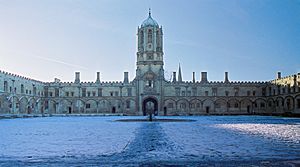
Whilst education in England is the responsibility of the Secretary of State for Education, the day-to-day administration and funding of state schools is the responsibility of local authorities. Universally free of charge state education was introduced piecemeal between 1870 and 1944. Education is now mandatory from ages 5 to 16, and in England youngsters must stay in education or training until they are 18. In 2011, the Trends in International Mathematics and Science Study (TIMSS) rated 13–14-year-old pupils in England and Wales 10th in the world for maths and 9th for science. The majority of children are educated in state-sector schools, a small proportion of which select on the grounds of academic ability. Two of the top 10 performing schools in terms of GCSE results in 2006 were state-run grammar schools. In 2010, over half of places at the University of Oxford and the University of Cambridge were taken by students from state schools, while the proportion of children in England attending private schools is around 7 per cent, which rises to 18 per cent of those over 16.
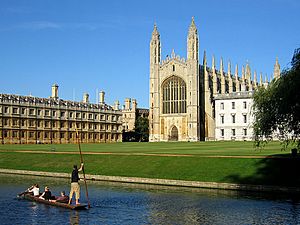
Scotland
Education in Scotland is the responsibility of the Cabinet Secretary for Education and Lifelong Learning, with day-to-day administration and funding of state schools the responsibility of Local Authorities. Two non-departmental public bodies have key roles in Scottish education. The Scottish Qualifications Authority is responsible for the development, accreditation, assessment and certification of qualifications other than degrees which are delivered at secondary schools, post-secondary colleges of further education and other centres. Learning and Teaching Scotland provides advice, resources and staff development to education professionals. Scotland first legislated for compulsory education in 1496. The proportion of children in Scotland attending private schools is just over 4 per cent in 2016, but it has been falling slowly in recent years. Scottish students who attend Scottish universities pay neither tuition fees nor graduate endowment charges, as fees were abolished in 2001 and the graduate endowment scheme was abolished in 2008.
Wales
The Welsh Government's Minister for Education has responsibility for education in Wales. State funded education is available to children from the age of three whilst the legal obligation for parents to have their children educated, usually at school, begins at age five. A significant proportion of pupils are educated in Welsh whilst the rest are obliged to study the language until the age of 16. Wales' performance in Pisa testing which compares the academic performance of adolescents around the world has improved in recent years but remains lower than other parts of the UK. In 2019, just under 60% of entrants passed their main English and maths GCSEs. The obligation to receive education in Wales ends at the age of 16. In 2017 and 2018, just under 80% of 16 to 18 and just under 40% of 19 to 24 year olds were in some kind of education or training.
Northern Ireland
Education in Northern Ireland is the responsibility of the Minister of Education, although responsibility at a local level is administered by the Education Authority which is further sub-divided into five geographical areas. The Council for the Curriculum, Examinations & Assessment (CCEA) is the body responsible for advising the government on what should be taught in Northern Ireland's schools, monitoring standards and awarding qualifications.
Native languages in the UK
Celtic languages
Germanic languages
Economy
Overview
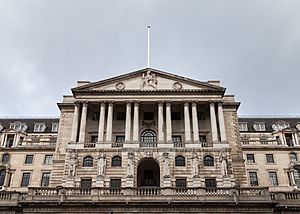
The UK has a partially regulated market economy. Based on market exchange rates, the UK is today the fifth-largest economy in the world and the second-largest in Europe after Germany. HM Treasury, led by the Chancellor of the Exchequer, is responsible for developing and executing the government's public finance policy and economic policy. The Bank of England is the UK's central bank and is responsible for issuing notes and coins in the nation's currency, the pound sterling. Banks in Scotland and Northern Ireland retain the right to issue their own notes, subject to retaining enough Bank of England notes in reserve to cover their issue. The pound sterling is the world's fourth-largest reserve currency (after the US dollar, euro, and Japanese Yen). Since 1997 the Bank of England's Monetary Policy Committee, headed by the Governor of the Bank of England, has been responsible for setting interest rates at the level necessary to achieve the overall inflation target for the economy that is set by the Chancellor each year.
The UK service sector makes up around 79 per cent of GDP. London is one of the world's largest financial centres, ranking 2nd in the world, behind New York City, in the Global Financial Centres Index in 2020. London also has the largest city GDP in Europe. Edinburgh ranks 17th in the world, and 6th in Western Europe in the Global Financial Centres Index in 2020. Tourism is very important to the British economy; with over 27 million tourists arriving in 2004, the United Kingdom is ranked as the sixth major tourist destination in the world and London has the most international visitors of any city in the world. The creative industries accounted for 7 per cent GVA in 2005 and grew at an average of 6 per cent per annum between 1997 and 2005.
Following the United Kingdom's withdrawal from the European Union, the functioning of the UK internal economic market is enshrined by the United Kingdom Internal Market Act 2020 which ensures trade in goods and services continues without internal barriers across the four countries of the United Kingdom.
The Industrial Revolution started in the UK with an initial concentration on the textile industry, followed by other heavy industries such as shipbuilding, coal mining and steelmaking. British merchants, shippers and bankers developed overwhelming advantage over those of other nations allowing the UK to dominate international trade in the 19th century. As other nations industrialised, coupled with economic decline after two world wars, the United Kingdom began to lose its competitive advantage and heavy industry declined, by degrees, throughout the 20th century. Manufacturing remains a significant part of the economy but accounted for only 16.7 per cent of national output in 2003.
The automotive industry employs around 800,000 people, with a turnover in 2015 of £70 billion, generating £34.6 billion of exports (11.8 per cent of the UK's total export goods). In 2015, the UK produced around 1.6 million passenger vehicles and 94,500 commercial vehicles. The UK is a major centre for engine manufacturing: in 2015 around 2.4 million engines were produced. The UK motorsport industry employs around 41,000 people, comprises around 4,500 companies and has an annual turnover of around £6 billion.
The aerospace industry of the UK is the second- or third-largest national aerospace industry in the world depending upon the method of measurement and has an annual turnover of around £30 billion.
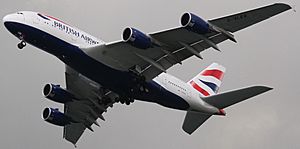
BAE Systems plays a critical role in some of the world's biggest defence aerospace projects. In the UK, the company makes large sections of the Typhoon Eurofighter and assembles the aircraft for the Royal Air Force. It is also a principal subcontractor on the F35 Joint Strike Fighter – the world's largest single defence project – for which it designs and manufactures a range of components. It also manufactures the Hawk, the world's most successful jet training aircraft. Airbus UK also manufactures the wings for the A400 m military transporter. Rolls-Royce is the world's second-largest aero-engine manufacturer. Its engines power more than 30 types of commercial aircraft and it has more than 30,000 engines in service in the civil and defence sectors.
The UK space industry was worth £9.1bn in 2011 and employed 29,000 people. It is growing at a rate of 7.5 per cent annually, according to its umbrella organisation, the UK Space Agency. In 2013, the British Government pledged £60 m to the Skylon project: this investment will provide support at a "crucial stage" to allow a full-scale prototype of the SABRE engine to be built.
The pharmaceutical industry plays an important role in the UK economy and the country has the third-highest share of global pharmaceutical R&D expenditures.
Agriculture is intensive, highly mechanised and efficient by European standards, producing about 60 per cent of food needs with less than 1.6 per cent of the labour force (535,000 workers). Around two-thirds of production is devoted to livestock, one-third to arable crops. The UK retains a significant, though much reduced fishing industry. It is also rich in a number of natural resources including coal, petroleum, natural gas, tin, limestone, iron ore, salt, clay, chalk, gypsum, lead, silica and an abundance of arable land.
In 2020, coronavirus lockdown measures caused the UK economy to suffer its biggest slump on record, shrinking by 20.4 per cent between April and June compared to the first three months of the year, to push it officially into recession for the first time in 11 years.
The UK has an external debt of $9.6 trillion dollars, which is the second-highest in the world after the US. As a percentage of GDP, external debt is 408 per cent, which is the third-highest in the world after Luxembourg and Iceland.
Science and technology
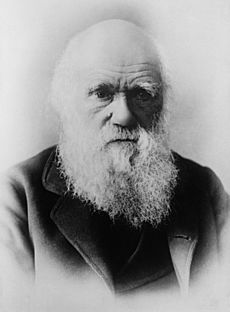
England and Scotland were leading centres of the Scientific Revolution from the 17th century. The United Kingdom led the Industrial Revolution from the 18th century, and has continued to produce scientists and engineers credited with important advances. Major theorists from the 17th and 18th centuries include Isaac Newton, whose laws of motion and illumination of gravity have been seen as a keystone of modern science; from the 19th century Charles Darwin, whose theory of evolution by natural selection was fundamental to the development of modern biology, and James Clerk Maxwell, who formulated classical electromagnetic theory; and more recently Stephen Hawking, who advanced major theories in the fields of cosmology, quantum gravity and the investigation of black holes.
Major scientific discoveries from the 18th century include hydrogen by Henry Cavendish; from the 20th century penicillin by Alexander Fleming, and the structure of DNA, by Francis Crick and others. Famous British engineers and inventors of the Industrial Revolution include James Watt, George Stephenson, Richard Arkwright, Robert Stephenson and Isambard Kingdom Brunel. Other major engineering projects and applications by people from the UK include the steam locomotive, developed by Richard Trevithick and Andrew Vivian; from the 19th century the electric motor by Michael Faraday, the first computer designed by Charles Babbage, the first commercial electrical telegraph by William Fothergill Cooke and Charles Wheatstone, the incandescent light bulb by Joseph Swan, and the first practical telephone, patented by Alexander Graham Bell; and in the 20th century the world's first working television system by John Logie Baird and others, the jet engine by Frank Whittle, the basis of the modern computer by Alan Turing, and the World Wide Web by Tim Berners-Lee.
Scientific research and development remains important in British universities, with many establishing science parks to facilitate production and co-operation with industry. Between 2004 and 2008 the UK produced 7 per cent of the world's scientific research papers and had an 8 per cent share of scientific citations, the third and second-highest in the world (after the United States and China, respectively). Scientific journals produced in the UK include Nature, the British Medical Journal and The Lancet. The United Kingdom was ranked 4th in the Global Innovation Index 2020 and 2021, up from 5th in 2019.
Transport

A radial road network totals 29,145 miles (46,904 km) of main roads, 2,173 miles (3,497 km) of motorways and 213,750 miles (344,000 km) of paved roads. The M25, encircling London, is the largest and busiest bypass in the world. In 2009 there were a total of 34 million licensed vehicles in Great Britain.
The rail network in the UK is the oldest such network in the world. The system consists of five high-speed main lines (the West Coast, East Coast, Midland, Great Western and Great Eastern), which radiate from London to the rest of the country, augmented by regional rail lines and dense commuter networks within the major cities. High Speed 1 is operationally separate from the rest of the network. The world's first passenger railway running on steam was the Stockton and Darlington Railway, opened in 1825. Just under five years later the world's first intercity railway was the Liverpool and Manchester Railway, designed by George Stephenson. The network grew rapidly as a patchwork of hundreds of separate companies during the Victorian era.
The UK has a railway network of 10,072 miles (16,209 km) in Great Britain and 189 miles (304 km) in Northern Ireland. Railways in Northern Ireland are operated by NI Railways, a subsidiary of state-owned Translink. In Great Britain, the British Rail network was privatised between 1994 and 1997, which was followed by a rapid rise in passenger numbers. The UK was ranked eighth among national European rail systems in the 2017 European Railway Performance Index assessing intensity of use, quality of service and safety. Network Rail owns and manages most of the fixed assets (tracks, signals etc.). HS2, a new high-speed railway line, is estimated to cost £56 billion. Crossrail, under construction in London, is Europe's largest construction project with a £15 billion projected cost.
In the year from October 2009 to September 2010 UK airports handled a total of 211.4 million passengers. In that period the three largest airports were London Heathrow Airport (65.6 million passengers), Gatwick Airport (31.5 million passengers) and London Stansted Airport (18.9 million passengers). London Heathrow Airport, located 15 miles (24 km) west of the capital, has the most international passenger traffic of any airport in the world and is the hub for the UK flag carrier British Airways, as well as Virgin Atlantic.
Energy
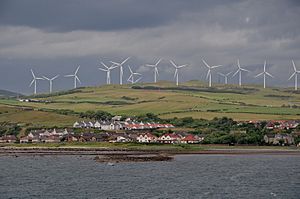
In 2006, the UK was the world's ninth-largest consumer of energy and the 15th-largest producer. The UK is home to a number of large energy companies, including two of the six oil and gas "supermajors" – BP and Shell.
In 2013, the UK produced 914 thousand barrels per day (bbl/d) of oil and consumed 1,507 thousand bbl/d. Production is now in decline and the UK has been a net importer of oil since 2005. In 2010[update] the UK had around 3.1 billion barrels of proven crude oil reserves, the largest of any EU member state.
In 2009, the UK was the 13th-largest producer of natural gas in the world and the largest producer in the EU. Production is now in decline and the UK has been a net importer of natural gas since 2004.
Coal production played a key role in the UK economy in the 19th and 20th centuries. In the mid-1970s, 130 million tonnes of coal were produced annually, not falling below 100 million tonnes until the early 1980s. During the 1980s and 1990s the industry was scaled back considerably. In 2011, the UK produced 18.3 million tonnes of coal. In 2005 it had proven recoverable coal reserves of 171 million tons. The UK Coal Authority has stated there is a potential to produce between 7 billion tonnes and 16 billion tonnes of coal through underground coal gasification (UCG) or 'fracking', and that, based on current UK coal consumption, such reserves could last between 200 and 400 years. Environmental and social concerns have been raised over chemicals getting into the water table and minor earthquakes damaging homes.
In the late 1990s, nuclear power plants contributed around 25 per cent of total annual electricity generation in the UK, but this has gradually declined as old plants have been shut down and ageing-related problems affect plant availability. In 2012, the UK had 16 reactors normally generating about 19 per cent of its electricity. All but one of the reactors will be retired by 2023. Unlike Germany and Japan, the UK intends to build a new generation of nuclear plants from about 2018.
The total of all renewable electricity sources provided for 38.9 per cent of the electricity generated in the United Kingdom in the third quarter of 2019, producing 28.8TWh of electricity. The UK is one of the best sites in Europe for wind energy, and wind power production is its fastest-growing supply, in 2019 it generated almost 20 per cent of the UK's total electricity.
Water supply and sanitation
Access to improved water supply and sanitation in the UK is universal. It is estimated that 96.7 per cent of households are connected to the sewer network. According to the Environment Agency, total water abstraction for public water supply in the UK was 16,406 megalitres per day in 2007.
In England and Wales water and sewerage services are provided by 10 private regional water and sewerage companies and 13 mostly smaller private "water only" companies. In Scotland, water and sewerage services are provided by a single public company, Scottish Water. In Northern Ireland water and sewerage services are also provided by a single public entity, Northern Ireland Water.
Education

Education in the United Kingdom is a devolved matter, with each country having a separate education system. About 38 percent of the United Kingdom population has a university or college degree, which is the highest percentage in Europe, and among the highest percentages in the world.
Whilst education in England is the responsibility of the Secretary of State for Education, the day-to-day administration and funding of state schools is the responsibility of local authorities. Universally free of charge state education was introduced piecemeal between 1870 and 1944. Education is now mandatory from ages five to sixteen, and in England youngsters must stay in education or training until they are 18. In 2011, the Trends in International Mathematics and Science Study (TIMSS) rated 13–14-year-old pupils in England and Wales 10th in the world for maths and 9th for science. The majority of children are educated in state-sector schools, a small proportion of which select on the grounds of academic ability. Two of the top ten performing schools in terms of GCSE results in 2006 were state-run grammar schools. In 2010, over half of places at the University of Oxford and the University of Cambridge were taken by students from state schools, while the proportion of children in England attending private schools is around 7% which rises to 18% of those over 16. England has the two oldest universities in English-speaking world, Universities of Oxford and Cambridge (jointly known as "Oxbridge") with history of over eight centuries. The United Kingdom trails only the United States in terms of representation on lists of top 100 universities.

Education in Scotland is the responsibility of the Cabinet Secretary for Education and Lifelong Learning, with day-to-day administration and funding of state schools the responsibility of Local Authorities. Two non-departmental public bodies have key roles in Scottish education. The Scottish Qualifications Authority is responsible for the development, accreditation, assessment and certification of qualifications other than degrees which are delivered at secondary schools, post-secondary colleges of further education and other centres. The Learning and Teaching Scotland provides advice, resources and staff development to education professionals. Scotland first legislated for compulsory education in 1496. The proportion of children in Scotland attending private schools is just over 4%, and it has been rising slowly in recent years. Scottish students who attend Scottish universities pay neither tuition fees nor graduate endowment charges, as fees were abolished in 2001 and the graduate endowment scheme was abolished in 2008.
The Welsh Government has responsibility for education in Wales. A significant number of Welsh students are taught either wholly or largely in the Welsh language; lessons in Welsh are compulsory for all until the age of 16. There are plans to increase the provision of Welsh-medium schools as part of the policy of creating a fully bilingual Wales.
Education in Northern Ireland is the responsibility of the Minister of Education and the Minister for Employment and Learning, although responsibility at a local level is administered by five education and library boards covering different geographical areas. The Council for the Curriculum, Examinations & Assessment (CCEA) is the body responsible for advising the government on what should be taught in Northern Ireland's schools, monitoring standards and awarding qualifications.
Culture
The culture of the United Kingdom has been influenced by many factors including: the nation's island status; its history as a western liberal democracy and a major power; as well as being a political union of four countries with each preserving elements of distinctive traditions, customs and symbolism. As a result of the British Empire, British influence can be observed in the language, culture and legal systems of many of its former colonies including Australia, Canada, India, Ireland, New Zealand, Pakistan, South Africa and the United States. The substantial cultural influence of the United Kingdom has led it to be described as a "cultural superpower".
Literature

'British literature' refers to literature associated with the United Kingdom, the Isle of Man and the Channel Islands. Most British literature is in the English language. In 2005, some 206,000 books were published in the United Kingdom and in 2006 it was the largest publisher of books in the world.
The English playwright and poet William Shakespeare is widely regarded as the greatest dramatist of all time, and his contemporaries Christopher Marlowe and Ben Jonson have also been held in continuous high esteem. More recently the playwrights Alan Ayckbourn, Harold Pinter, Michael Frayn, Tom Stoppard and David Edgar have combined elements of surrealism, realism and radicalism.
Notable pre-modern and early-modern English writers include Geoffrey Chaucer (14th century), Thomas Malory (15th century), Sir Thomas More (16th century), John Bunyan (17th century) and John Milton (17th century). In the 18th century Daniel Defoe (author of Robinson Crusoe) and Samuel Richardson were pioneers of the modern novel. In the 19th century there followed further innovation by Jane Austen, the gothic novelist Mary Shelley, the children's writer Lewis Carroll, the Brontë sisters, the social campaigner Charles Dickens, the naturalist Thomas Hardy, the realist George Eliot, the visionary poet William Blake and romantic poet William Wordsworth. 20th century English writers include the science-fiction novelist H. G. Wells; the writers of children's classics Rudyard Kipling, A. A. Milne (the creator of Winnie-the-Pooh), Roald Dahl and Enid Blyton; the controversial D. H. Lawrence; the modernist Virginia Woolf; the satirist Evelyn Waugh; the prophetic novelist George Orwell; the popular novelists W. Somerset Maugham and Graham Greene; the crime writer Agatha Christie (the best-selling novelist of all time); Ian Fleming (the creator of James Bond); the poets T.S. Eliot, Philip Larkin and Ted Hughes; the fantasy writers J. R. R. Tolkien, C. S. Lewis and J. K. Rowling; the graphic novelists Alan Moore and Neil Gaiman.
Scotland's contributions include the detective writer Arthur Conan Doyle (the creator of Sherlock Holmes), romantic literature by Sir Walter Scott, the children's writer J. M. Barrie, the epic adventures of Robert Louis Stevenson and the celebrated poet Robert Burns. More recently the modernist and nationalist Hugh MacDiarmid and Neil M. Gunn contributed to the Scottish Renaissance. A more grim outlook is found in Ian Rankin's stories and the psychological horror-comedy of Iain Banks. Scotland's capital, Edinburgh, was UNESCO's first worldwide City of Literature.
Britain's oldest known poem, Y Gododdin, was composed in Yr Hen Ogledd (The Old North), most likely in the late 6th century. It was written in Cumbric or Old Welsh and contains the earliest known reference to King Arthur. From around the seventh century, the connection between Wales and the Old North was lost, and the focus of Welsh-language culture shifted to Wales, where Arthurian legend was further developed by Geoffrey of Monmouth. Wales's most celebrated medieval poet, Dafydd ap Gwilym (fl.1320–1370), composed poetry on themes including nature, religion and especially love. He is widely regarded as one of the greatest European poets of his age. Until the late 19th century the majority of Welsh literature was in Welsh and much of the prose was religious in character. Daniel Owen is credited as the first Welsh-language novelist, publishing Rhys Lewis in 1885. The best-known of the Anglo-Welsh poets are both Thomases. Dylan Thomas became famous on both sides of the Atlantic in the mid-20th century. He is remembered for his poetry—his "Do not go gentle into that good night; Rage, rage against the dying of the light" is one of the most quoted couplets of English language verse—and for his "play for voices", Under Milk Wood. The influential Church in Wales "poet-priest" and Welsh nationalist R. S. Thomas was nominated for the Nobel Prize in Literature in 1996. Leading Welsh novelists of the twentieth century include Richard Llewellyn and Kate Roberts.
Authors of other nationalities, particularly from Commonwealth countries, the Republic of Ireland and the United States, have lived and worked in the UK. Significant examples through the centuries include Jonathan Swift, Oscar Wilde, Bram Stoker, George Bernard Shaw, Joseph Conrad, T.S. Eliot, Ezra Pound and more recently British authors born abroad such as Kazuo Ishiguro and Sir Salman Rushdie.
Music
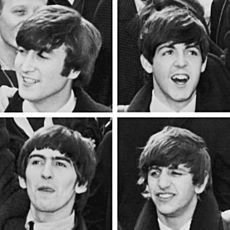
Various styles of music are popular in the UK from the indigenous folk music of England, Wales, Scotland and Northern Ireland to heavy metal. Notable composers of classical music from the United Kingdom and the countries that preceded it include William Byrd, Henry Purcell, Sir Edward Elgar, Gustav Holst, Sir Arthur Sullivan (most famous for working with the librettist Sir W. S. Gilbert), Ralph Vaughan Williams and Benjamin Britten, pioneer of modern British opera. Sir Harrison Birtwistle is one of the foremost living composers. The UK is also home to world-renowned symphonic orchestras and choruses such as the BBC Symphony Orchestra and the London Symphony Chorus. Notable conductors include Sir Simon Rattle, Sir John Barbirolli and Sir Malcolm Sargent. Some of the notable film score composers include John Barry, Clint Mansell, Mike Oldfield, John Powell, Craig Armstrong, David Arnold, John Murphy, Monty Norman and Harry Gregson-Williams. George Frideric Handel became a naturalised British citizen and wrote the British coronation anthem, while some of his best works, such as Messiah, were written in the English language. Andrew Lloyd Webber is a prolific composer of musical theatre. His works have dominated London's West End since the late 20th century and have also been a commercial success worldwide.
The Beatles have international sales of over one billion units and are the biggest-selling and most influential band in the history of popular music. Other prominent British contributors to have influenced popular music over the last 50 years include; The Rolling Stones, Led Zeppelin, Pink Floyd, Queen, the Bee Gees, and Elton John, all of whom have worldwide record sales of 200 million or more. The Brit Awards are the BPI's annual music awards, and some of the British recipients of the Outstanding Contribution to Music award include; The Who, David Bowie, Eric Clapton, Rod Stewart and The Police. More recent UK music acts that have had international success include Coldplay, Radiohead, Oasis, Spice Girls, Robbie Williams, Amy Winehouse and Adele.
A number of UK cities are known for their music. Acts from Liverpool have had more UK chart number one hit singles per capita (54) than any other city worldwide. Glasgow's contribution to music was recognised in 2008 when it was named a UNESCO City of Music, one of only three cities in the world to have this honour.
Visual art
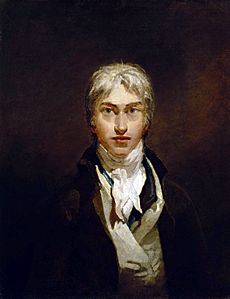
The history of British visual art forms part of western art history. Major British artists include: the Romantics William Blake, John Constable, Samuel Palmer and J.M.W. Turner; the portrait painters Sir Joshua Reynolds and Lucian Freud; the landscape artists Thomas Gainsborough and L. S. Lowry; the pioneer of the Arts and Crafts Movement William Morris; the figurative painter Francis Bacon; the Pop artists Peter Blake, Richard Hamilton and David Hockney; the collaborative duo Gilbert and George; the abstract artist Howard Hodgkin; and the sculptors Antony Gormley, Anish Kapoor and Henry Moore. During the late 1980s and 1990s the Saatchi Gallery in London helped to bring to public attention a group of multi-genre artists who would become known as the "Young British Artists": Damien Hirst, Chris Ofili, Rachel Whiteread, Tracey Emin, Mark Wallinger, Steve McQueen, Sam Taylor-Wood and the Chapman Brothers are among the better-known members of this loosely affiliated movement.
The Royal Academy in London is a key organisation for the promotion of the visual arts in the United Kingdom. Major schools of art in the UK include: the six-school University of the Arts London, which includes the Central Saint Martins College of Art and Design and Chelsea College of Art and Design; Goldsmiths, University of London; the Slade School of Fine Art (part of University College London); the Glasgow School of Art; the Royal College of Art; and The Ruskin School of Drawing and Fine Art (part of the University of Oxford). The Courtauld Institute of Art is a leading centre for the teaching of the history of art. Important art galleries in the United Kingdom include the National Gallery, National Portrait Gallery, Tate Britain and Tate Modern (the most-visited modern art gallery in the world, with around 4.7 million visitors per year).
Cinema

The United Kingdom has had a considerable influence on the history of the cinema. The British directors Alfred Hitchcock, whose film Vertigo is considered by some critics as the best film of all time, and David Lean are among the most critically acclaimed of all-time. Other important directors including Charlie Chaplin, Michael Powell, Carol Reed and Ridley Scott. Many British actors have achieved international fame and critical success, including: Julie Andrews, Richard Burton, Michael Caine, Charlie Chaplin, Sean Connery, Vivien Leigh, David Niven, Laurence Olivier, Peter Sellers, Kate Winslet, Anthony Hopkins, and Daniel Day-Lewis. Some of the most commercially successful films of all time have been produced in the United Kingdom, including two of the highest-grossing film franchises (Harry Potter and James Bond). Ealing Studios has a claim to being the oldest continuously working film studio in the world.
Despite a history of important and successful productions, the industry has often been characterised by a debate about its identity and the level of American and European influence. British producers are active in international co-productions and British actors, directors and crew feature regularly in American films. Many successful Hollywood films have been based on British people, stories or events, including Titanic, The Lord of the Rings, Pirates of the Caribbean.
In 2009, British films grossed around $2 billion worldwide and achieved a market share of around 7% globally and 17% in the United Kingdom. UK box-office takings totalled £944 million in 2009, with around 173 million admissions. The British Film Institute has produced a poll ranking of what it considers to be the 100 greatest British films of all time, the BFI Top 100 British films. The annual British Academy Film Awards are hosted by the British Academy of Film and Television Arts.
Media
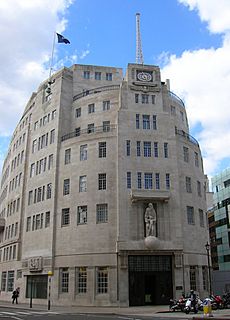
The BBC, founded in 1922, is the UK's publicly funded radio, television and Internet broadcasting corporation, and is the oldest and largest broadcaster in the world. It operates numerous television and radio stations in the UK and abroad and its domestic services are funded by the television licence. Other major players in the UK media include ITV plc, which operates 11 of the 15 regional television broadcasters that make up the ITV Network, and News Corporation, which owns a number of national newspapers through News International such as the most popular tabloid The Sun and the longest-established daily "broadsheet" The Times, as well as holding a large stake in satellite broadcaster British Sky Broadcasting. London dominates the media sector in the UK: national newspapers and television and radio are largely based there, although Manchester is also a significant national media centre. Edinburgh and Glasgow, and Cardiff, are important centres of newspaper and broadcasting production in Scotland and Wales respectively. The UK publishing sector, including books, directories and databases, journals, magazines and business media, newspapers and news agencies, has a combined turnover of around £20 billion and employs around 167,000 people.
In 2009, it was estimated that individuals viewed a mean of 3.75 hours of television per day and 2.81 hours of radio. In that year the main BBC public service broadcasting channels accounted for an estimated 28.4% of all television viewing; the three main independent channels accounted for 29.5% and the increasingly important other satellite and digital channels for the remaining 42.1%. Sales of newspapers have fallen since the 1970s and in 2010 41% of people reported reading a daily national newspaper. In 2010, 82.5% of the UK population were Internet users, the highest proportion amongst the 20 countries with the largest total number of users in that year.
Sport
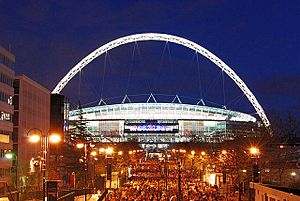
Major sports, including association football, tennis, rugby union, rugby league, golf, boxing, netball, rowing and cricket, originated or were substantially developed in the UK and the states that preceded it. With the rules and codes of many modern sports invented and codified in late 19th century Victorian Britain, in 2012, the President of the IOC, Jacques Rogge, stated; "This great, sports-loving country is widely recognized as the birthplace of modern sport. It was here that the concepts of sportsmanship and fair play were first codified into clear rules and regulations. It was here that sport was included as an educational tool in the school curriculum".
In most international competitions, separate teams represent England, Scotland and Wales. Northern Ireland and the Republic of Ireland usually field a single team representing all of Ireland, with notable exceptions being association football and the Commonwealth Games. In sporting contexts, the English, Scottish, Welsh and Irish / Northern Irish teams are often referred to collectively as the Home Nations. There are some sports in which a single team represents the whole of United Kingdom, including the Olympics, where the UK is represented by the Great Britain team. The 1908, 1948 and 2012 Summer Olympics were held in London, making it the first city to host the games three times. Britain has participated in every modern Olympic Games to date and is third in the medal count.
A 2003 poll found that football is the most popular sport in the United Kingdom. England is recognised by FIFA as the birthplace of club football, and The Football Association is the oldest of its kind, with the rules of football first drafted in 1863 by Ebenezer Cobb Morley. Each of the Home Nations has its own football association, national team and league system. The English top division, the Premier League, is the most watched football league in the world. The first-ever international football match was contested by England and Scotland on 30 November 1872. England, Scotland, Wales and Northern Ireland compete as separate countries in international competitions. A Great Britain Olympic football team was assembled for the first time to compete in the London 2012 Olympic Games. However, the Scottish, Welsh and Northern Irish football associations declined to participate, fearing that it would undermine their independent status—a fear confirmed by FIFA.
In 2003, rugby union was ranked the second most popular sport in the UK. The sport was created in Rugby School, Warwickshire, and the first rugby international took place on 27 March 1871 between England and Scotland. England, Scotland, Wales, Ireland, France and Italy compete in the Six Nations Championship; the premier international tournament in the northern hemisphere. Sport governing bodies in England, Scotland, Wales and Ireland organise and regulate the game separately. If any of the British teams or the Irish team beat the other three in a tournament, then it is awarded the Triple Crown.
Cricket was invented in England, and its laws were established by Marylebone Cricket Club in 1788. The England cricket team, controlled by the England and Wales Cricket Board, is the only national team in the UK with Test status. Team members are drawn from the main county sides, and include both English and Welsh players. Cricket is distinct from football and rugby where Wales and England field separate national teams, although Wales had fielded its own team in the past. Irish and Scottish players have played for England because neither Scotland nor Ireland have Test status and have only recently started to play in One Day Internationals. Scotland, England (and Wales), and Ireland (including Northern Ireland) have competed at the Cricket World Cup, with England reaching the finals on three occasions. There is a professional league championship in which clubs representing 17 English counties and 1 Welsh county compete.
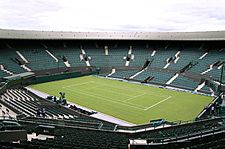
The modern game of tennis originated in Birmingham, England, in the 1860s, before spreading around the world. The world's oldest tennis tournament, the Wimbledon championships, first occurred in 1877, and today the event takes place over two weeks in late June and early July.
Thoroughbred racing, which originated under Charles II of England as the "sport of kings", is popular throughout the UK with world-famous races including the Grand National, the Epsom Derby, Royal Ascot and the Cheltenham National Hunt Festival (including the Cheltenham Gold Cup). The UK has proved successful in the international sporting arena in rowing.
The UK is closely associated with motorsport. Many teams and drivers in Formula One (F1) are based in the UK, and the country has won more drivers' and constructors' titles than any other. The UK hosted the first F1 Grand Prix in 1950 at Silverstone, the current location of the British Grand Prix held each year in July. The UK hosts legs of the Grand Prix motorcycle racing, World Rally Championship and FIA World Endurance Championship. The premier national auto racing event is the British Touring Car Championship. Motorcycle road racing has a long tradition with races such as the Isle of Man TT and the North West 200.
Golf is the sixth most popular sport, by participation, in the UK. Although The Royal and Ancient Golf Club of St Andrews in Scotland is the sport's home course, the world's oldest golf course is actually Musselburgh Links' Old Golf Course. In 1764, the standard 18-hole golf course was created at St Andrews when members modified the course from 22 to 18 holes. The oldest golf tournament in the world, and the first major championship in golf, The Open Championship, is played annually on the weekend of the third Friday in July.
Rugby league originated in Huddersfield, West Yorkshire in 1895 and is generally played in Northern England. A single 'Great Britain Lions' team had competed in the Rugby League World Cup and Test match games, but this changed in 2008 when England, Scotland and Ireland competed as separate nations. Great Britain is still retained as the full national team. Super League is the highest level of professional rugby league in the UK and Europe. It consists of 11 teams from Northern England, 1 from London, 1 from Wales and 1 from France.
The 'Queensberry rules', the code of general rules in boxing, was named after John Douglas, 9th Marquess of Queensberry in 1867, that formed the basis of modern boxing. Snooker is another of the UK's popular sporting exports, with the world championships held annually in Sheffield. In Northern Ireland Gaelic football and hurling are popular team sports, both in terms of participation and spectating, and Irish expatriates in the UK and the US also play them. Shinty (or camanachd) is popular in the Scottish Highlands. Highland games are held in spring and summer in Scotland, celebrating Scottish and celtic culture and heritage, especially that of the Scottish Highlands.
Symbols
The flag of the United Kingdom is the Union Flag (also referred to as the Union Jack). It was created in 1606 by the superimposition of the Flag of England on the Flag of Scotland and updated in 1801 with the addition of Saint Patrick's Flag. Wales is not represented in the Union Flag, as Wales had been conquered and annexed to England prior to the formation of the United Kingdom. The possibility of redesigning the Union Flag to include representation of Wales has not been completely ruled out. The national anthem of the United Kingdom is "God Save the King", with "King" replaced with "Queen" in the lyrics whenever the monarch is a woman.
Britannia is a national personification of the United Kingdom, originating from Roman Britain. Britannia is symbolised as a young woman with brown or golden hair, wearing a Corinthian helmet and white robes. She holds Poseidon's three-pronged trident and a shield, bearing the Union Flag. Sometimes she is depicted as riding on the back of a lion. Since the height of the British Empire in the late 19th century, Britannia has often been associated with British maritime dominance, as in the patriotic song "Rule, Britannia!". Up until 2008, the lion symbol was depicted behind Britannia on the British fifty pence coin and on the back of the British ten pence coin. It is also used as a symbol on the non-ceremonial flag of the British Army.
A second, less used, personification of the nation is the character John Bull. The bulldog is sometimes used as a symbol of the United Kingdom and has been associated with Winston Churchill's defiance of Nazi Germany.
Transport
Road traffic in the United Kingdom drives on the left hand side of the road (unlike the Americas and some of Europe), and the driver steers from the right hand side of the vehicle. The road network on the island of Great Britain is extensive, with most local and rural roads having evolved from Roman and Medieval times. Major routes developed in the mid 20th Century were made to the needs of the motor car. The high speed motorway (freeway) network was mostly constructed in the 1960s and 1970s and links together major towns and cities.
The system of rail transport was invented in England and Wales, so the United Kingdom has the oldest railway network in the world. It was built mostly during the Victorian era. At the heart of the network are five long distance main lines which radiate from London to the major cities and secondary population centres with dense commuter networks within the regions. The newest part of the network connects London to the Channel Tunnel from St Pancras station and is built to the same standard as the French TGV system. The British Rail network is part privatised, with privately owned train operating companies providing service along particular lines or regions, whilst the tracks, signals and stations are owned by a Government controlled company called Network Rail. In Northern Ireland the NI Railways is the national railway. The system of underground railways in London, known as the Tube, has been copied by many other cities.
Most domestic air travel in the United Kingdom is between London and the major cities in Scotland and the North of England and Belfast. London-Heathrow is the nation’s largest airport and is one of the most important international hubs in the world. Other major airports with principal international service include London-Gatwick, Birmingham, Manchester and Glasgow.
An extensive system of ferry networks operate between the Scottish islands, and major ferry routes operate between England and France (via the English Channel), Scotland-Northern Ireland (via the Irish Sea) and England/Wales-Republic of Ireland (from Liverpool/Holyhead).
Images for kids
-
Wembley Stadium, London, home of the England national football team, is the fifth most expensive stadium ever built.
-
Wimbledon, the oldest Grand Slam tennis tournament, is held in Wimbledon, London every June and July.
See also
 In Spanish: Reino Unido para niños
In Spanish: Reino Unido para niños




